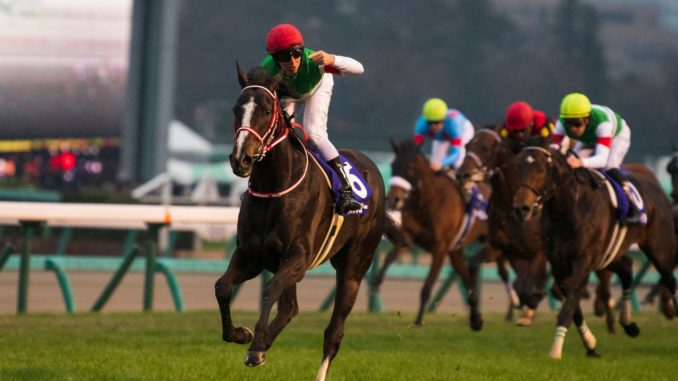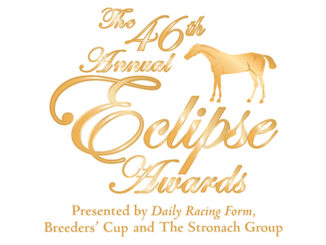
As we look ahead to the Jan. 23 Eclipse Awards gala that will reveal the U.S. champions of 2019, it’s worth observing that we’re not the only major racing jurisdiction with a couple of hotly contested divisional awards. The Japan Racing Association announced its annual champions last week, posing a few comparisons and contrasts with the U.S. scene.
The Horse of the Year title rightly went to Lys Gracieux in a landslide (271 of 274 votes cast), honoring her historic Cox Plate (G1) victory along with her Tazarazuka Kinen (G1) and Arima Kinen (G1) trophies at home. By definition, she was also the champion older filly or mare for the second straight year, with only a trio of holdouts for Almond Eye preventing a unanimous decision for the divisional crown.
That offers perspective, without direct correspondence, to similar American awards. Midnight Bisou is likely to dominate the balloting for older dirt female, but she wasn’t a finalist for Horse of the Year, possibly because she didn’t face males. In contrast, two of the finalists for champion turf female did face and beat males – Uni in the Breeders’ Cup Mile (G1) and Got Stormy in the Fourstardave (G1). Thus the ability to step outside distaff ranks speaks volumes the world over.
The Japanese older male division wasn’t so clear-cut. Voters were split between the claims of Win Bright, whose marquee wins came at about 10 furlongs in Hong Kong, and Indy Champ, who turned the prestigious Yasuda Kinen (G1)/Mile Championship (G1) double. Win Bright edged Indy Champ for the older male title (136-118), while Indy Champ was the runaway winner in the sprinter or miler category with 211 votes.
Might we take that as a preview of the comparable Eclipse Award vote here? Mitole is a lock for champion sprinter honors but also ranks as a finalist in the older dirt male category. His leading rival in that bracket is Vino Rosso, the Breeders’ Cup Classic (G1) winner who has this point in common with Win Bright – top-level scores at 1 1/4 miles. And without pushing the individual parallels too far, Mitole like Indy Champ excelled at a shorter trip that has its own divisional award. (The sharpest difference is that Indy Champ lost more often than Mitole.)
Other very rough parallels come with both 3-year-old divisions. While the Kentucky Derby (G1) was handed to the 65-1 Country House via disqualification, the Tokyo Yushun (Japanese Derby) (G1) went the way of a 92-1 shot in Roger Barows. And reminiscent of how Country House was sidelined for the rest of the year, Roger Barows retired with an injury and never had an opportunity to back up his shock win.
Saturnalia, fourth as the favorite at Tokyo, ended up winning the champion 3-year-old colt title with just one major win in 2019. That came in the first colts’ classic, the Satsuki Sho (Japanese 2000 Guineas) (G1). Saturnalia added the Sept. 22 Kobe Shimbun Hai (G2) against fellow sophomores, and although beaten in both tries versus older horses, he likely clinched the vote by placing second to Lys Gracieux in the Dec. 22 Arima Kinen.
But Saturnalia just eked it out by a 124-107 tally over Admire Mars, the Satsuki Sho fourth who thrived back down in trip in the NHK Mile Cup (G1) and the Hong Kong Mile (G1) over elders. The American sophomore picture, for all its differences, was also in flux until last month when Derby demotee Maximum Security probably wrapped it up in the Cigar Mile (G1).
The Japanese 3-year-old filly title was almost as close. Miler Gran Alegria – winner of the first fillies’ classic, the Oka Sho (Japanese 1000 Guineas) (G1) – beat out Yushun Himba (Japanese Oaks) (G1) heroine Loves Only You in a 121-99 vote. Her romp over older males in the Dec. 22 Hanshin Cup (G2), in a blistering 1:19.40 for about 7 furlongs, put her over the top.
Might we view this as a prognosticator for the 3-year-old filly Eclipse? Again, allowing for the granular differences, Covfefe was superior going shorter while her rivals in the broader divisional category might not have distinguished themselves enough for the voters. Unlike Japan, we have a champion female sprinter category, which is why I voted for Covfefe there and opted for Guarana in the 3-year-old filly division. Still, there’s a distinct possibility that the Eclipse electorate will give Covfefe both awards.
The 2-year-old filly picture was totally one-sided in Japan. Resistencia took all 274 votes in recognition of an unbeaten season topped by the Hanshin Juvenile Fillies (G1) in record time. The U.S. division probably won’t be unanimous, but undefeated British Idiom likewise presents a 3-for-3 resume including the Breeders’ Cup Juvenile Fillies (G1).
Japan was blessed with a pair of outstanding 2-year-old colts who never met each other, so it was a slight surprise (to me anyway) that the vote wasn’t close between Contrail and fellow unbeaten Salios. Contrail won hands down by 197-77. Voters were more persuaded by his Hopeful (G1), and record time in the Tokyo Sports Hai Nisai (G3), than Salios’ record clocking in the Saudi Arabia Royal Cup (G3) and new stakes record in the Asahi Hai Futurity (G1).
The thought-provoking angle for U.S. fans is that the Asahi Hai Futurity has been synonymous with the championship honor for more than 30 years. You have to go back to 1987 (Soccer Boy) to find a Japanese champion 2-year-old colt who didn’t win that race. That’s even more deterministic than the Breeders’ Cup Juvenile (G1)!
The Hopeful has a distinguished honor roll itself, but the about 1 1/4-mile test is more for juveniles with scope to peak in the classics. Contrail’s dynamic display in the Hopeful, over the same course and distance as the Satsuki Sho, has whet the appetite for next spring.
Given Storm the Court’s 45-1 upset of the Breeders’ Cup Juvenile, it would be understandable for the Eclipse electorate to deviate from its historical norm as well. But the Japanese voters had a positive reason to vote for Contrail, not a negative one against Salios who was decisive in all three starts. In their case, the traditional championship race produced a worthy winner, but they judged another even better. The U.S. voters had a harder time trying to identify our analog to Contrail.
Our Horse of the Year won’t be a true analog to Lys Gracieux, since all three finalists – Bricks and Mortar, Maximum Security, and Mitole – are males who didn’t venture abroad. But Bricks and Mortar shares the Lys Gracieux profile as a turf supremo with marquee wins at different distances, crowned by the season’s climax in the Breeders’ Cup Turf (G1). Should Bricks and Mortar win the golden statuette, he’ll have to celebrate from his new stud home…in Japan.



